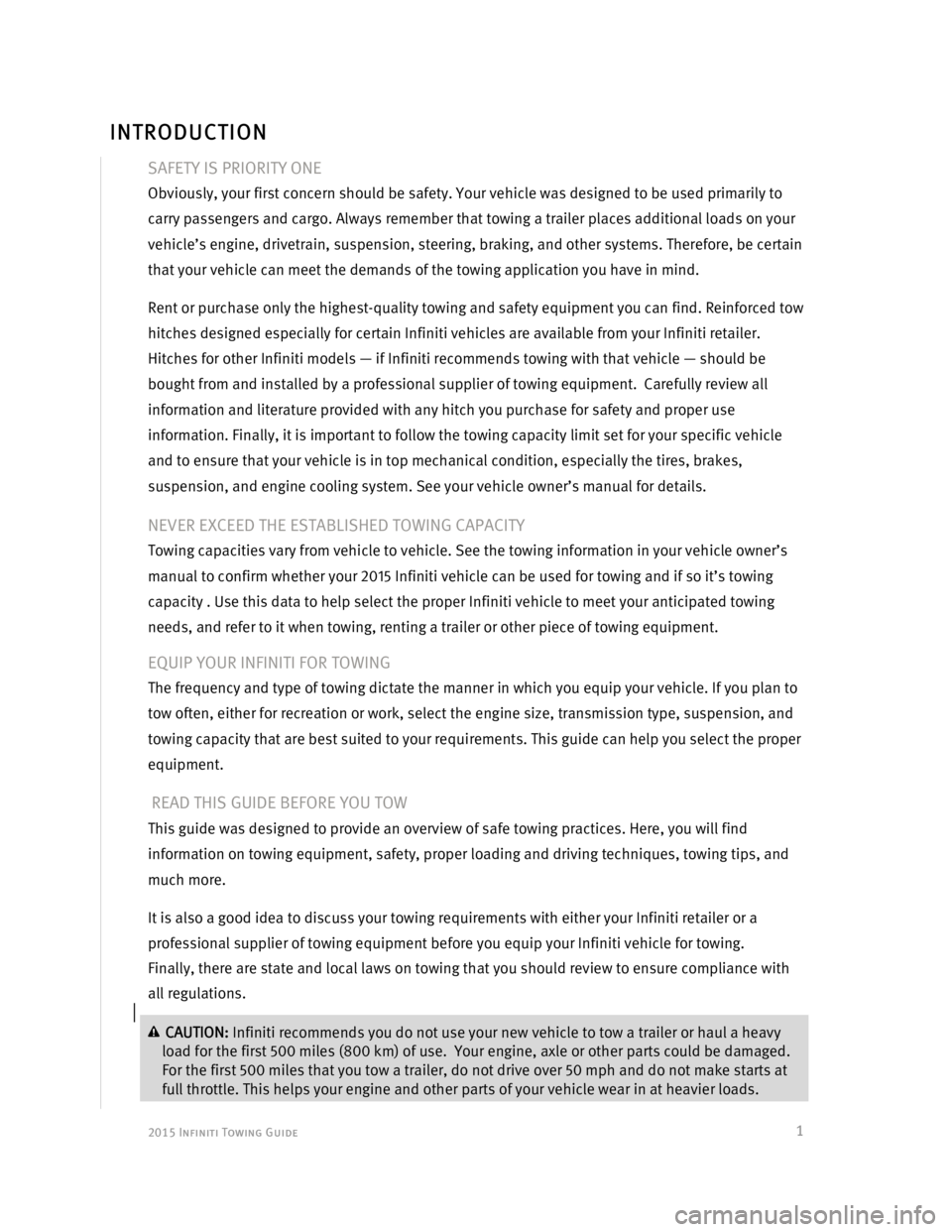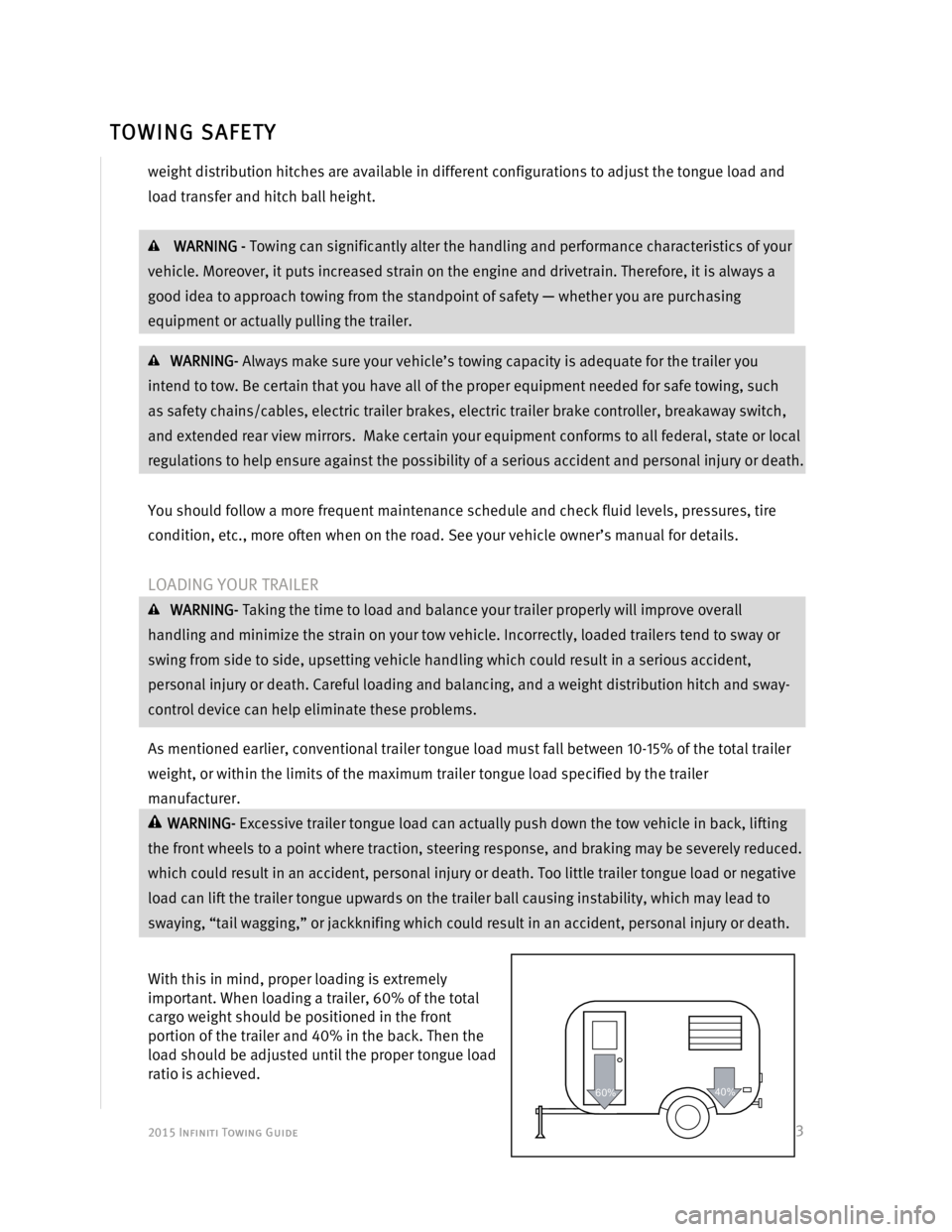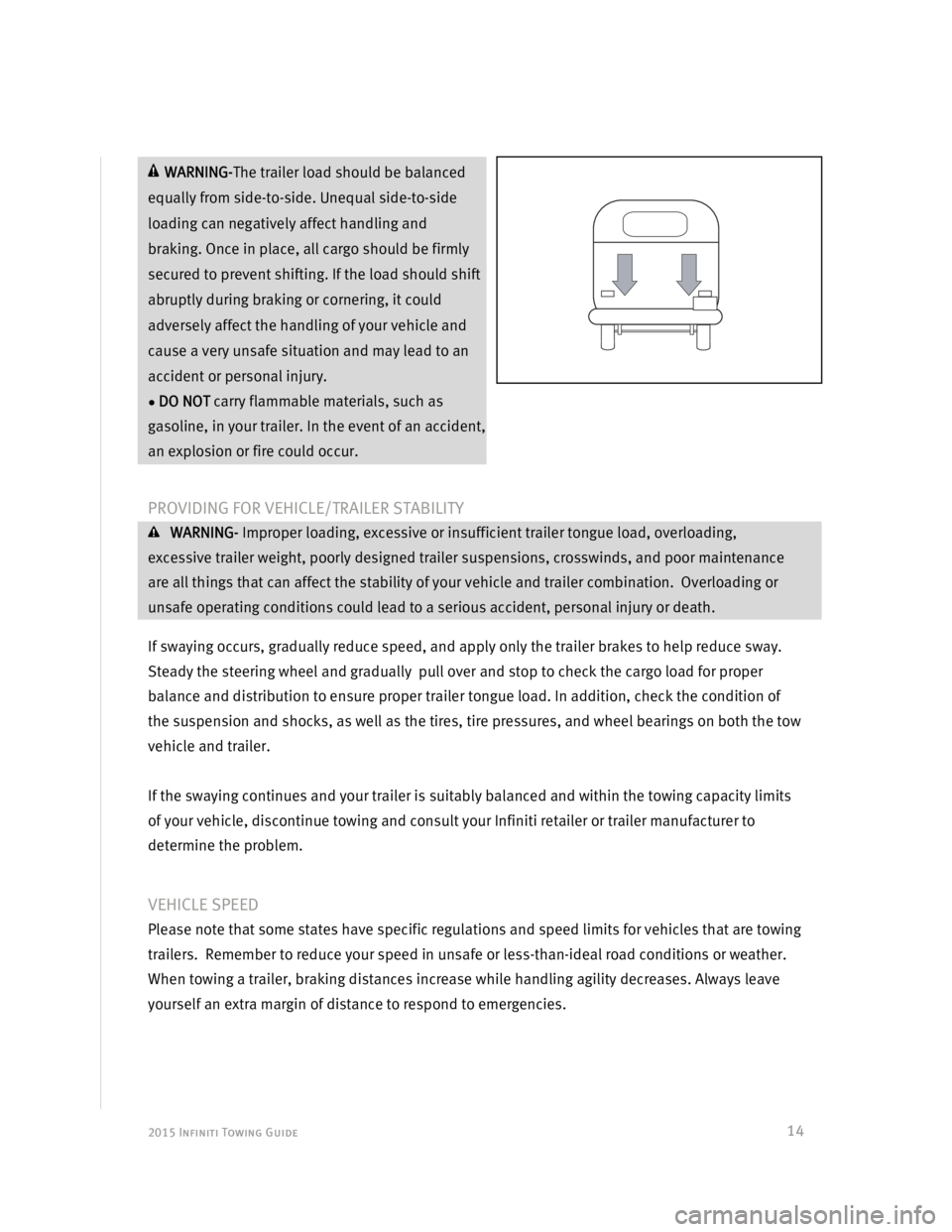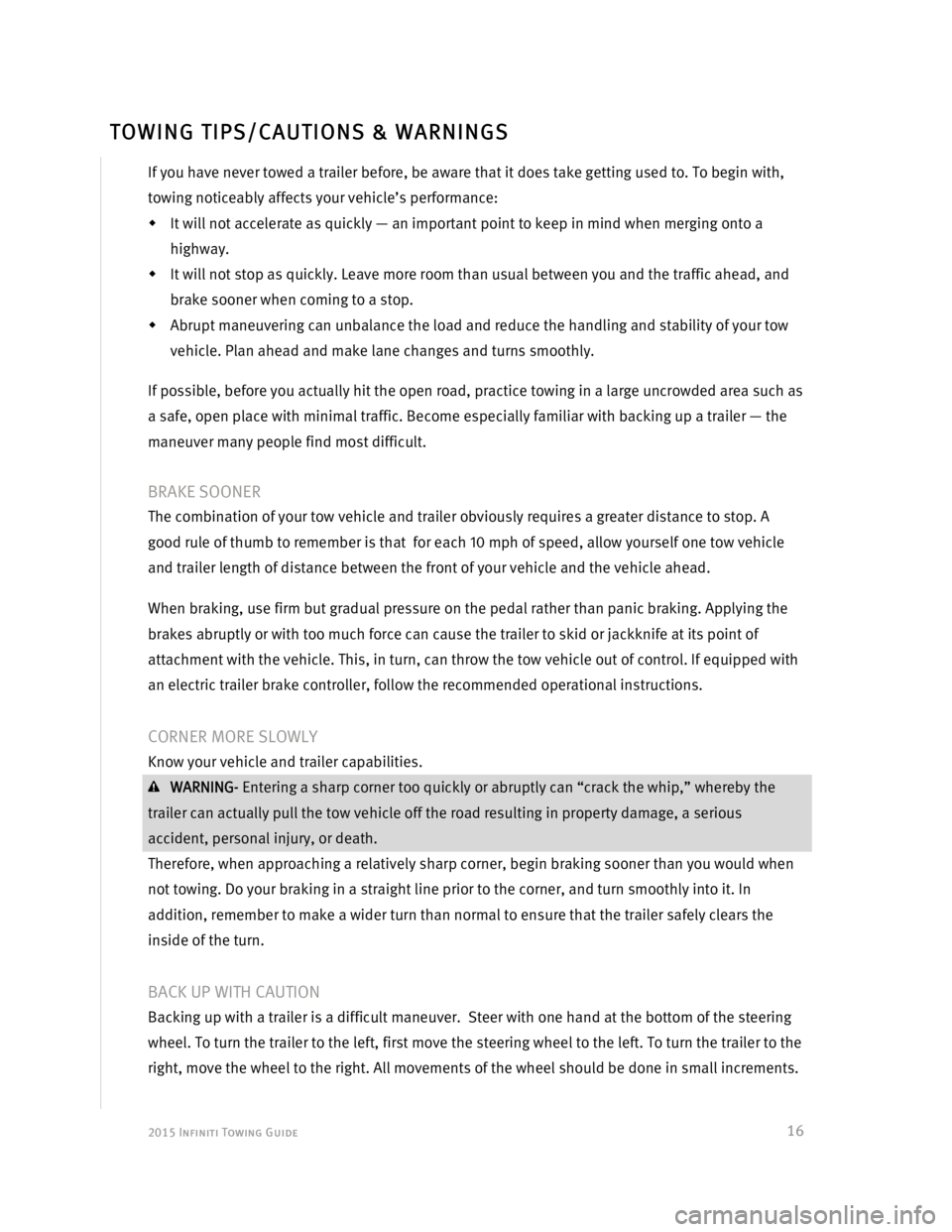steering INFINITI Q60 COUPE 2015 Towing Guide
[x] Cancel search | Manufacturer: INFINITI, Model Year: 2015, Model line: Q60 COUPE, Model: INFINITI Q60 COUPE 2015Pages: 25, PDF Size: 0.42 MB
Page 2 of 25

2015 Infiniti Towing Guide
1
SAFETY IS PRIORITY ONE
Obviously, your first concern should be safety. Your vehicle was designed to be used primarily to
carry passengers and cargo. Always remember that towing a trailer places additional loads on your
vehicle’s engine, drivetrain, suspension, steering, braking, and other systems. Therefore, be certain
that your vehicle can meet the demands of the towing application you have in mind.
Rent or purchase only the highest-quality towing and safety equipment you can find. Reinforced tow
hitches designed especially for certain Infiniti vehicles are available from your Infiniti retailer.
Hitches for other Infiniti models — if Infiniti recommends towing with that vehicle — should be
bought from and installed by a professional supplier of towing equipment. Carefully review all
information and literature provided with any hitch you purchase for safety and proper use
information. Finally, it is important to follow the towing capacity limit set for your specific vehicle
and to ensure that your vehicle is in top mechanical condition, especially the tires, brakes,
suspension, and engine cooling system. See your vehicle owner’s manual for details.
NEVER EXCEED THE ESTABLISHED TOWING CAPACITY
Towing capacities vary from vehicle to vehicle. See the towing information in your vehicle owner’s
manual to confirm whether your 2015 Infiniti vehicle can be used for towing and if so it’s towing
capacity . Use this data to help select the proper Infiniti vehicle to meet your anticipated towing
needs, and refer to it when towing, renting a trailer or other piece of towing equipment.
EQUIP YOUR INFINITI FOR TOWING
The frequency and type of towing dictate the manner in which you equip your vehicle. If you plan to
tow often, either for recreation or work, select the engine size, transmission type, suspension, and
towing capacity that are best suited to your requirements. This guide can help you select the proper
equipment.
READ THIS GUIDE BEFORE YOU TOW
This guide was designed to provide an overview of safe towing practices. Here, you will find
information on towing equipment, safety, proper loading and driving techniques, towing tips, and
much more.
It is also a good idea to discuss your towing requirements with either your Infiniti retailer or a
professional supplier of towing equipment before you equip your Infiniti vehicle for towing.
Finally, there are state and local laws on towing that you should review to ensure compliance with
all regulations.
CAUTION: Infiniti recommends you do not use your new vehicle to tow a trailer or haul a heavy
load for the first 500 miles (800 km) of use. Your engine, axle or other parts could be damaged.
For the first 500 miles that you tow a trailer, do not drive over 50 mph and do not make starts at
full throttle. This helps your engine and other parts of your vehicle wear in at heavier loads.
INTRODUCTION
Page 14 of 25

2015 Infiniti Towing Guide
13
weight distribution hitches are available in different configurations to adjust the tongue load and
load transfer and hitch ball height.
WARNING - Towing can significantly alter the handling and performance characteristics of your
vehicle. Moreover, it puts increased strain on the engine and drivetrain. Therefore, it is always a
good idea to approach towing from the standpoint of safety — whether you are purchasing
equipment or actually pulling the trailer.
WARNING- Always make sure your vehicle’s towing capacity is adequate for the trailer you
intend to tow. Be certain that you have all of the proper equipment needed for safe towing, such
as safety chains/cables, electric trailer brakes, electric trailer brake controller, breakaway switch,
and extended rear view mirrors. Make certain your equipment conforms to all federal, state or local
regulations to help ensure against the possibility of a serious accident and personal injury or death.
You should follow a more frequent maintenance schedule and check fluid levels, pressures, tire
condition, etc., more often when on the road. See your vehicle owner’s manual for details.
LOADING YOUR TRAILER
WARNING- Taking the time to load and balance your trailer properly will improve overall
handling and minimize the strain on your tow vehicle. Incorrectly, loaded trailers tend to sway or
swing from side to side, upsetting vehicle handling which could result in a serious accident,
personal injury or death. Careful loading and balancing, and a weight distribution hitch and sway-
control device can help eliminate these problems.
As mentioned earlier, conventional trailer tongue load must fall between 10-15% of the total trailer
weight, or within the limits of the maximum trailer tongue load specified by the trailer
manufacturer.
WARNING- Excessive trailer tongue load can actually push down the tow vehicle in back, lifting
the front wheels to a point where traction, steering response, and braking may be severely reduced.
which could result in an accident, personal injury or death. Too little trailer tongue load or negative
load can lift the trailer tongue upwards on the trailer ball causing instability, which may lead to
swaying, “tail wagging,” or jackknifing which could result in an accident, personal injury or death.
With this in mind, proper loading is extremely
important. When loading a trailer, 60% of the total
cargo weight should be positioned in the front
portion of the trailer and 40% in the back. Then the
load should be adjusted until the proper tongue load
ratio is achieved.
60%40%
TOWING SAFETY
Page 15 of 25

2015 Infiniti Towing Guide
14
WARNING-The trailer load should be balanced
equally from side-to-side. Unequal side-to-side
loading can negatively affect handling and
braking. Once in place, all cargo should be firmly
secured to prevent shifting. If the load should shift
abruptly during braking or cornering, it could
adversely affect the handling of your vehicle and
cause a very unsafe situation and may lead to an
accident or personal injury.
● DO NOT carry flammable materials, such as
gasoline, in your trailer. In the event of an accident,
an explosion or fire could occur.
PROVIDING FOR VEHICLE/TRAILER STABILITY
WARNING- Improper loading, excessive or insufficient trailer tongue load, overloading,
excessive trailer weight, poorly designed trailer suspensions, crosswinds, and poor maintenance
are all things that can affect the stability of your vehicle and trailer combination. Overloading or
unsafe operating conditions could lead to a serious accident, personal injury or death.
If swaying occurs, gradually reduce speed, and apply only the trailer brakes to help reduce sway.
Steady the steering wheel and gradually pull over and stop to check the cargo load for proper
balance and distribution to ensure proper trailer tongue load. In addition, check the condition of
the suspension and shocks, as well as the tires, tire pressures, and wheel bearings on both the tow
vehicle and trailer.
If the swaying continues and your trailer is suitably balanced and within the towing capacity limits
of your vehicle, discontinue towing and consult your Infiniti retailer or trailer manufacturer to
determine the problem.
VEHICLE SPEED
Please note that some states have specific regulations and speed limits for vehicles that are towing
trailers. Remember to reduce your speed in unsafe or less-than-ideal road conditions or weather.
When towing a trailer, braking distances increase while handling agility decreases. Always leave
yourself an extra margin of distance to respond to emergencies.
Page 17 of 25

2015 Infiniti Towing Guide
16
If you have never towed a trailer before, be aware that it does take getting used to. To begin with,
towing noticeably affects your vehicle’s performance:
It will not accelerate as quickly — an important point to keep in mind when merging onto a
highway.
It will not stop as quickly. Leave more room than usual between you and the traffic ahead, and
brake sooner when coming to a stop.
Abrupt maneuvering can unbalance the load and reduce the handling and stability of your tow
vehicle. Plan ahead and make lane changes and turns smoothly.
If possible, before you actually hit the open road, practice towing in a large uncrowded area such as
a safe, open place with minimal traffic. Become especially familiar with backing up a trailer — the
maneuver many people find most difficult.
BRAKE SOONER
The combination of your tow vehicle and trailer obviously requires a greater distance to stop. A
good rule of thumb to remember is that for each 10 mph of speed, allow yourself one tow vehicle
and trailer length of distance between the front of your vehicle and the vehicle ahead.
When braking, use firm but gradual pressure on the pedal rather than panic braking. Applying the
brakes abruptly or with too much force can cause the trailer to skid or jackknife at its point of
attachment with the vehicle. This, in turn, can throw the tow vehicle out of control. If equipped with
an electric trailer brake controller, follow the recommended operational instructions.
CORNER MORE SLOWLY
Know your vehicle and trailer capabilities.
WARNING- Entering a sharp corner too quickly or abruptly can “crack the whip,” whereby the
trailer can actually pull the tow vehicle off the road resulting in property damage, a serious
accident, personal injury, or death.
Therefore, when approaching a relatively sharp corner, begin braking sooner than you would when
not towing. Do your braking in a straight line prior to the corner, and turn smoothly into it. In
addition, remember to make a wider turn than normal to ensure that the trailer safely clears the
inside of the turn.
BACK UP WITH CAUTION
Backing up with a trailer is a difficult maneuver. Steer with one hand at the bottom of the steering
wheel. To turn the trailer to the left, first move the steering wheel to the left. To turn the trailer to the
right, move the wheel to the right. All movements of the wheel should be done in small increments.
TOWING TIPS/CAUTIONS & WARNINGS